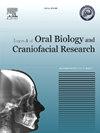营养状况对日惹6-9岁印尼儿童牙发育和下颌骨密度的影响
Q1 Medicine
Journal of oral biology and craniofacial research
Pub Date : 2025-02-24
DOI:10.1016/j.jobcr.2025.02.010
引用次数: 0
摘要
儿童的生长发育在很大程度上取决于他们的营养状况;因此,营养缺乏会严重影响牙齿和骨骼的成熟。牙齿的成熟程度可以用来衡量牙齿的发育。下颌骨密度(MBD)可以直接影响某些侵入性手术,如拔牙和牙科创伤管理。本研究旨在确定营养状况对6-9岁儿童牙齿成熟和MBD的影响。材料与方法本研究使用108张该年龄段儿童的全景x线片,并将其分为低、中、高营养状态三组。营养状况根据身高年龄比(H/A) z-得分确定,采用WHO H/A图。牙成熟评分采用Nolla法计算左侧7颗下颌骨牙的总评分。通过分形分析,MBD测量为三个感兴趣区域(ROI)的平均分形维数值:左下颌骨髁突、角、第二前磨牙和第一恒磨牙下方。数据分析采用牙齿成熟水平的单因素方差分析和MBD的Kruskal-Wallis检验(95% CI)。结果不同营养状态组牙成熟水平差异有统计学意义,低营养组牙成熟明显慢于其他各组。MBD在营养状况组之间没有显着差异。结论营养状况对牙成熟水平有影响,而MBD对牙成熟水平无影响。本文章由计算机程序翻译,如有差异,请以英文原文为准。

Effect of nutritional status on dental maturation and mandibular bone density among Indonesian children aged 6–9 Years in Yogyakarta
Introduction
Growth and development in children depend significantly on their nutritional status; therefore, nutritional deficiencies can greatly influence dental and bone maturity. The level of dental maturation can be used to measure dental development. Mandibular bone density (MBD) can directly impact certain invasive procedures, such as extractions and dental trauma management. This study aimed to determine the influence of nutritional status on dental maturation and MBD in children aged 6–9 years.
Materials and methods
The study used 108 panoramic radiographs from children in this age and divided them into three groups: low, moderate, and high nutritional status. The nutritional status was determined on the basis of height-for-age (H/A) z-scores using the WHO H/A chart. The dental maturity score was calculated as the total score of the seven mandibular teeth in the left region using the Nolla method. Using fractal analysis, MBD was measured as the average fractal dimension values from three regions of interest (ROI): the condyle, angle, and below the second premolar and first permanent molar of the left mandible. Data were analyzed using one-way ANOVA for dental maturation levels and the Kruskal-Wallis test for MBD (95 % CI).
Results
The results showed significant differences in dental maturation levels between the nutritional status groups, with dental maturation in the low-nutrition group being significantly slower than in the other groups. The MBD showed no significant differences between the nutritional status groups.
Conclusion
This study concluded that nutritional status influences the level of dental maturation, but not MBD.
求助全文
通过发布文献求助,成功后即可免费获取论文全文。
去求助
来源期刊

Journal of oral biology and craniofacial research
Medicine-Otorhinolaryngology
CiteScore
4.90
自引率
0.00%
发文量
133
审稿时长
167 days
期刊介绍:
Journal of Oral Biology and Craniofacial Research (JOBCR)is the official journal of the Craniofacial Research Foundation (CRF). The journal aims to provide a common platform for both clinical and translational research and to promote interdisciplinary sciences in craniofacial region. JOBCR publishes content that includes diseases, injuries and defects in the head, neck, face, jaws and the hard and soft tissues of the mouth and jaws and face region; diagnosis and medical management of diseases specific to the orofacial tissues and of oral manifestations of systemic diseases; studies on identifying populations at risk of oral disease or in need of specific care, and comparing regional, environmental, social, and access similarities and differences in dental care between populations; diseases of the mouth and related structures like salivary glands, temporomandibular joints, facial muscles and perioral skin; biomedical engineering, tissue engineering and stem cells. The journal publishes reviews, commentaries, peer-reviewed original research articles, short communication, and case reports.
 求助内容:
求助内容: 应助结果提醒方式:
应助结果提醒方式:


